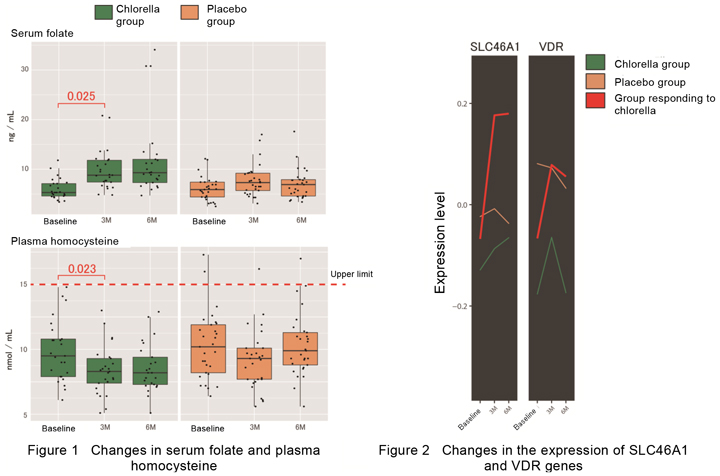- TOP
- List of reports
- Chlorella intake and folate metabolism-Findings from a 6 month, double blind,
randomized placebo controlled trial in healthy males-
Chlorella intake and folate metabolism-Findings from a 6 month, double blind, randomized placebo controlled trial in healthy males-
【Scientific information】
Research and Development Department, Sun Chlorella Corporation
Chlorella intake and folate metabolism
-Findings from a 6 month, double blind, randomized placebo controlled trial in healthy males-
Presented at the second academic meeting of Society for Chlorella and Functional Plants Research
- Objective
- Homocysteine (THCY) is metabolized through 3 pathways, one of which requires 5-methyltetrahydrofolate and vitamin B12 coenzyme. Chlorella contains 1,400 μg of folate and 230 μg of vitamin B12 per 100 g. We have reported that taking 6 to 8 g chlorella daily increased the blood levels of folate and vitamin B12 and decreased the blood level of THCY. However, no one has comprehensively analyzed folate-related genes in a placebo controlled trial.
We therefore conducted a 6-month, randomized, double-blind, randomized placebo-controlled trial to assess changes in folate-related genes by microarray analysis using changes in the blood levels of folate and THCY as parameters.
- Methods
- Males aged 40 to under the age of 55 were randomly allocated to 2 groups (30 subjects/group) and given tablets containing 8 g chlorella or placebo tablets without chlorella every day for 6 months. Blood was drawn every 3 months from the start of this study to measure serum folate and plasma THCY levels as well as to analyze the expression of folate-related genes by microarray testing. As folate-associated genes, 156 genes that were screened by folate and Homo sapiens among PubMed Genes were analyzed.
- Results
- No adverse events attributable to the test food were found. In the chlorella group, folate was significantly increased (p = 0.025) by approximately 2.1-fold at 3 months and remained at the level until the end of the study. In addition, THCY was significantly decreased (p = 0.023) at 3 months in the chlorella group and remained at the level until the end of the study (Figure 1). In subjects who had low folate and high THCY levels at baseline (group responding to chlorella), the expression of SLC46A1*1 was markedly increased and in addition VDR*2, a receptor of vitamin D which is suggested to be involved in the amount of SLC46A1, was also increased (Figure 2).
These results indicated that chlorella intake was not only a source of folate but also increased the expression of genes involved in its metabolism. It was also suggested that the responsiveness to chlorella differs depending on the status of folate and THCY in blood.

Terminology
- *1: SLC46A1
- This is a folate transporter that absorbs folate in the small intestine and a mutation in the SLC46A1 gene is known to result in hereditary folate malabsorption.
- *2: VDR
- This is a receptor that regulates DNA transcription upon vitamin D binding in the cell nucleus.
Details
- Academic society:
- The second academic meeting of Society for Chlorella and Functional Plants Research
- Title:
- Chlorella intake and folate metabolism Findings from a 6 month, double blind, randomized placebo controlled trial in healthy males
- Authors:
- Masaki Fujishima, Eri Okumura, Toru Mizoguchi, Hitoshi Kubota, and Hideo Takekoshi
- Affiliation:
- Sun Chlorella Corporation





